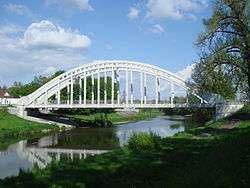Darkov

![]() Darkov (Polish: Darków , German: Darkau) is a village in Karviná District, Moravian-Silesian Region, Czech Republic, now administratively a part of the city of Karviná. Till 1948 it was a separate municipality. It lies on the Olza River, in the historical region of Cieszyn Silesia. Darkov has a population of 406 (2001).[1]
Darkov (Polish: Darków , German: Darkau) is a village in Karviná District, Moravian-Silesian Region, Czech Republic, now administratively a part of the city of Karviná. Till 1948 it was a separate municipality. It lies on the Olza River, in the historical region of Cieszyn Silesia. Darkov has a population of 406 (2001).[1]
The name is possessive in origin derived from personal name Darek.[2]
History

Some sources state that the village was first mentioned in a Latin document of Diocese of Wrocław called Liber fundationis episcopatus Vratislaviensis from around 1305 as item in Bertholdi villa debent esse XLV mansi,[2][3][4] however it is unlikely and disputed.[5][lower-alpha 1] Surely it was later mentioned in a written document in 1447 as Darkow.[2][6] Politically it belonged initially to the Duchy of Teschen, a fee of the Kingdom of Bohemia, which after 1526 became part of the Habsburg Monarchy. In 1573 it was sold as one of a dozen villages and the town of Freistadt and formed a state country split from the Duchy of Teschen.[7]
After the Revolutions of 1848 in the Austrian Empire a modern municipal division was introduced in the re-established Austrian Silesia. The village as a municipality was subscribed at first to the political district of Teschen and the legal district of Freistadt, which in 1868 became an independent political district. According to the censuses conducted in 1880, 1890, 1900 and 1910 the population of the municipality grew from 614 in 1880 to 2,305 in 1910 with a majority being native Polish-speakers (dropping from 97.4% in 1880 to 94.8% in 1900, then growing to 96.5% in 1910) accompanied by German-speaking (between 1.8% and 3.9%) and Czech-speaking people (between 0.3% and 1.3%). In terms of religion in 1910 the majority were Roman Catholics (2,042 or 88.6%), followed by Protestants (223 or 9.7%) and Jews (39 or 1.7%).[8][9] The village was also traditionally inhabited by Silesian Lachs, speaking Cieszyn Silesian dialect.
After World War I, the fall of Austria-Hungary, the Polish–Czechoslovak War and the division of Cieszyn Silesia in 1920, the village became a part of Czechoslovakia. Following the Munich Agreement, in October 1938 together with the Zaolzie region it was annexed by Poland, administratively organised in Frysztat County of Silesian Voivodeship.[10] The village was then annexed by Nazi Germany at the beginning of World War II. After the war it was restored to Czechoslovakia.
The village is well known for its Darkov Spa facilities, established in 1866 which treats various diseases, mostly diseases of locomotive organs, conditions after accidents and operations etc. It has one of the best iodine-bromine waters in Central Europe.
Prominent landmark is a bridge on the Olza built in 1924-1925, located just near the spa. In 1991 it was inscribed on the state register of technical landmarks. It was renovated in the 2000s.
Darkov together with neighboring villages suffered of under-mining caused by nearby coal mines. This affected the character of the village as many inhabitants relocated to nearby villages and towns, thus seriously depopulating the village.
People
- Józef Ondrusz, Polish folklorist and writer
Notes
Footnotes
- ↑ "Historický lexikon obcí České republiky 1869 - 2005 - 1. díl" (PDF). Praha: Czech Statistical Office. 2006. pp. 718–719.
- 1 2 3 Mrózek, Robert (1984). Nazwy miejscowe dawnego Śląska Cieszyńskiego [Local names of former Cieszyn Silesia] (in Polish). Katowice: Uniwersytet Śląski w Katowicach. p. 57. ISSN 0208-6336.
- ↑ Schulte, Wilhelm (1889). Codex Diplomaticus Silesiae T.14 Liber Fundationis Episcopatus Vratislaviensis (in German). Breslau.
- ↑ "Liber fundationis episcopatus Vratislaviensis" (in Latin). Retrieved 13 July 2014.
- 1 2 Panic, Idzi (2010). Śląsk Cieszyński w średniowieczu (do 1528) [Cieszyn Silesia in Middle Ages (until 1528)] (in Polish). Cieszyn: Starostwo Powiatowe w Cieszynie. p. 299. ISBN 978-83-926929-3-5.
- ↑ Hosák et al. 1970, 171.
- ↑ Panic, Idzi (2011). Śląsk Cieszyński w początkach czasów nowożytnych (1528-1653) [Cieszyn Silesia in the beginnings of Modern Era (1528-1653)] (in Polish). Cieszyn: Starostwo Powiatowe w Cieszynie. pp. 226–227. ISBN 978-83-926929-5-9.
- ↑ Piątkowski, Kazimierz (1918). Stosunki narodowościowe w Księstwie Cieszyńskiem (in Polish). Cieszyn: Macierz Szkolna Księstwa Cieszyńskiego. pp. 273, 290.
- ↑ Ludwig Patryn (ed): Die Ergebnisse der Volkszählung vom 31. Dezember 1910 in Schlesien, Troppau 1912.
- ↑ "Ustawa z dnia 27 października 1938 r. o podziale administracyjnym i tymczasowej organizacji administracji na obszarze Ziem Odzyskanych Śląska Cieszyńskiego". Dziennik Ustaw Śląskich (in Polish). Katowice. nr 18/1938, poz. 35. 31 October 1938. Retrieved 1 July 2014.
References
- Cicha, Irena; Jaworski, Kazimierz; Ondraszek, Bronisław; Stalmach, Barbara; Stalmach, Jan (2000). Olza od pramene po ujście. Český Těšín: Region Silesia. ISBN 80-238-6081-X.
- Hosák, Ladislav; Rudolf Šrámek (1970). Místní jména na Moravě a ve Slezsku I, A-L. Praha: Academia.
- Owczarzy, Władysław (October 2007). "Zabytek techniki". Zwrot: 49.
External links
| Wikimedia Commons has media related to Darkov. |
- (in English) Website of Darkov Spa
- (in Czech) Darkov information with historical and contemporary photos
Coordinates: 49°50′24″N 18°32′34″E / 49.84000°N 18.54278°E